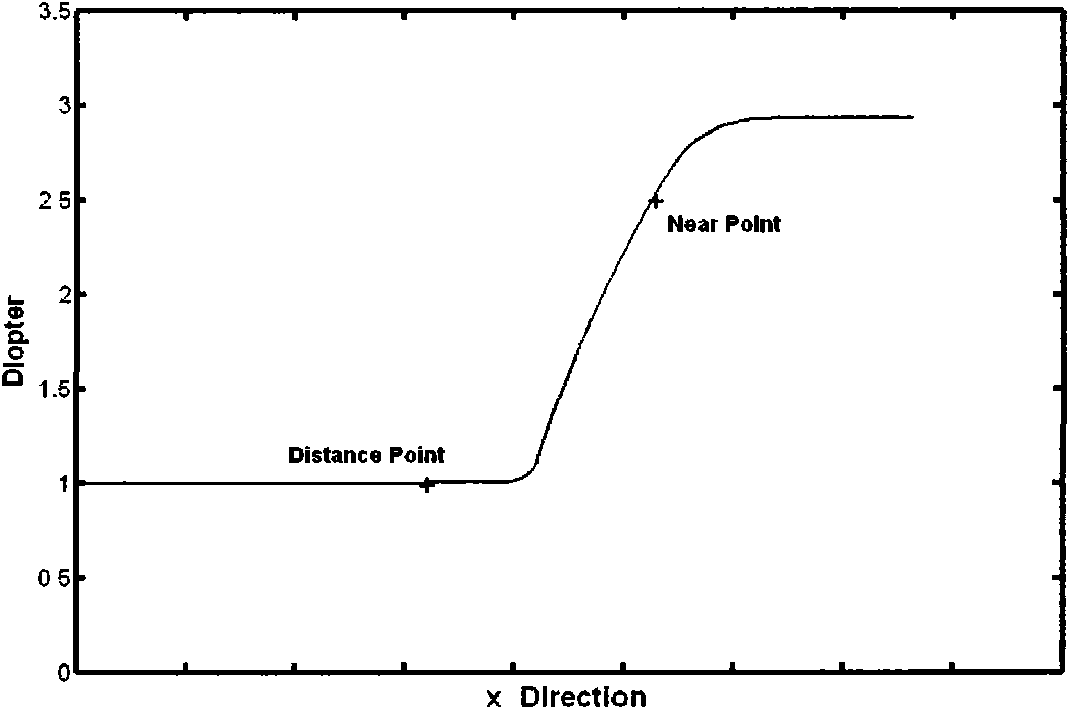Method for designing ophthalmic progressive additional lens by utilizing meridian
A progressive multifocal and ophthalmic lens technology, applied in glasses/goggles, optics, instruments, etc., can solve problems such as single function requirements and inability to design progressive multifocal ophthalmic lenses suitable for different use occasions
- Summary
- Abstract
- Description
- Claims
- Application Information
AI Technical Summary
Problems solved by technology
Method used
Image
Examples
example 1
[0075] Example 1: The preset progressive multifocal ophthalmic lens has a far point lens power of 100 degrees, an addition power of 150 degrees between the far point of vision and the near point of vision, the lens channel length h=21 mm, and the distance point of vision A and the center of the lens The pitch of the dots L=7mm. The lens diameter is 60mm and the refractive index is 1.499.
[0076] Figure 5 and Figure 6 They are the average sphere diagram of the progressive multifocal ophthalmic lens and the astigmatism distribution diagram of the progressive multifocal ophthalmic lens in Embodiment 1 of the present invention, respectively. Depend on image 3 It can be seen from the graph that the diopter along the meridian of the lens remains basically unchanged in the far vision zone, and gradually increases from the far vision point to the near vision zone. The diopter change coincides with the designed meridian, and the astigmatism and distortion are very small.
example 2
[0077] Example 2: Using the lens parameters described in Example 1, using the meridian diopter curve as attached Figure 7 , this curve is also calculated according to the above-mentioned meridian diopter change curve equation, but the values of m and l are different from those in Example 1, so the meridian diopter curve is also different. The diopter changes almost linearly, and the diopter slowly tends to a stable value outside the far point and the near point, and tends to a stable value slowly outside the far point, and the diopter value is small, and then after the near point Tends faster to a smaller diopter value.
[0078] Figure 9 and Figure 10 They are the average sphere diagram of the progressive multifocal ophthalmic lens and the astigmatism distribution diagram of the progressive multifocal ophthalmic lens in Example 2 of the present invention, respectively.
[0079] It can be seen from Example 1 and Example 2 that although the design parameters of the lens ...
PUM
| Property | Measurement | Unit |
|---|---|---|
| Diameter | aaaaa | aaaaa |
Abstract
Description
Claims
Application Information
 Login to View More
Login to View More - R&D
- Intellectual Property
- Life Sciences
- Materials
- Tech Scout
- Unparalleled Data Quality
- Higher Quality Content
- 60% Fewer Hallucinations
Browse by: Latest US Patents, China's latest patents, Technical Efficacy Thesaurus, Application Domain, Technology Topic, Popular Technical Reports.
© 2025 PatSnap. All rights reserved.Legal|Privacy policy|Modern Slavery Act Transparency Statement|Sitemap|About US| Contact US: help@patsnap.com



